Citroen C3 RHD 2015 2.G Owner's Manual
Manufacturer: CITROEN, Model Year: 2015, Model line: C3 RHD, Model: Citroen C3 RHD 2015 2.GPages: 324, PDF Size: 9.86 MB
Page 121 of 324
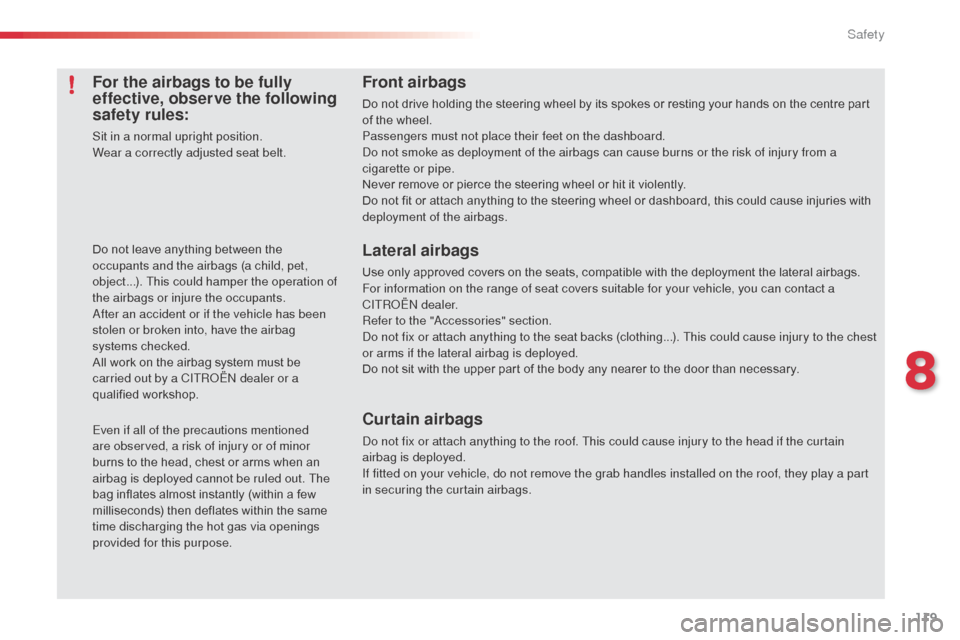
119
For the airbags to be fully
effective, observe the following
safety rules:
Sit in a normal upright position.
Wear a correctly adjusted seat belt.
Do not leave anything between the
occupants and the airbags (a child, pet,
object...). This could hamper the operation of
the airbags or injure the occupants.
af
ter an accident or if the vehicle has been
stolen or broken into, have the airbag
systems checked.
All work on the airbag system must be
carried out by a CITR
oËn
dealer or a
qualified workshop.
Even if all of the precautions mentioned
are observed, a risk of injury or of minor
burns to the head, chest or arms when an
airbag is deployed cannot be ruled out. The
bag inflates almost instantly (within a few
milliseconds) then deflates within the same
time discharging the hot gas via openings
provided for this purpose.
Front airbags
Do not drive holding the steering wheel by its spokes or resting your hands on the centre part
of the wheel.
Passengers must not place their feet on the dashboard.
do n
ot smoke as deployment of the airbags can cause burns or the risk of injury from a
cigarette or pipe.
Never remove or pierce the steering wheel or hit it violently.
Do not fit or attach anything to the steering wheel or dashboard, this could cause injuries with
deployment of the airbags.
Lateral airbags
Use only approved covers on the seats, compatible with the deployment the lateral airbags.
For information on the range of seat covers suitable for your vehicle, you can contact a
CITR
oËn
dealer.
Refer to the "
ac
cessories" section.
do n
ot fix or attach anything to the seat backs (clothing...). This could cause injury to the chest
or arms if the lateral airbag is deployed.
Do not sit with the upper part of the body any nearer to the door than necessary.
Curtain airbags
do not fix or attach anything to the roof. This could cause injury to the head if the curtain
airbag is deployed.
If fitted on your vehicle, do not remove the grab handles installed on the roof, they play a part
in securing the curtain airbags.
8
Safety
Page 122 of 324
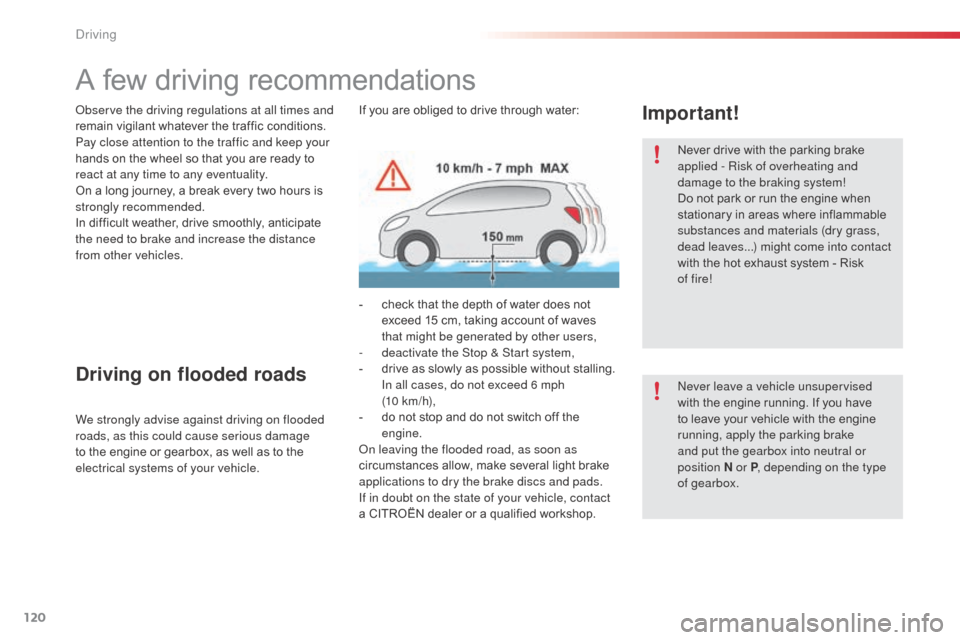
120
A few driving recommendations
Never drive with the parking brake
applied - Risk of overheating and
damage to the braking system!
Do not park or run the engine when
stationary in areas where inflammable
substances and materials (dry grass,
dead leaves...) might come into contact
with the hot exhaust system - Risk
of fire!
ne
ver leave a vehicle unsupervised
with the engine running. If you have
to leave your vehicle with the engine
running, apply the parking brake
and put the gearbox into neutral or
position
N or P, depending on the type
of gearbox.
ob
serve the driving regulations at all times and
remain vigilant whatever the traffic conditions.
Pay close attention to the traffic and keep your
hands on the wheel so that you are ready to
react at any time to any eventuality.
On a long journey, a break every two hours is
strongly recommended.
In difficult weather, drive smoothly, anticipate
the need to brake and increase the distance
from other vehicles.
Driving on flooded roads
We strongly advise against driving on flooded
roads, as this could cause serious damage
to the engine or gearbox, as well as to the
electrical systems of your vehicle. -
c
heck that the depth of water does not
exceed 15 cm, taking account of waves
that might be generated by other users,
-
d
eactivate the Stop & Start system,
-
d
rive as slowly as possible without stalling.
In all cases, do not exceed 6 mph
(10 km/h),
- d o not stop and do not switch off the
engine.
on l
eaving the flooded road, as soon as
circumstances allow, make several light brake
applications to dry the brake discs and pads.
If in doubt on the state of your vehicle, contact
a CITROËN dealer or a qualified workshop. If you are obliged to drive through water:
Important!
driving
Page 123 of 324
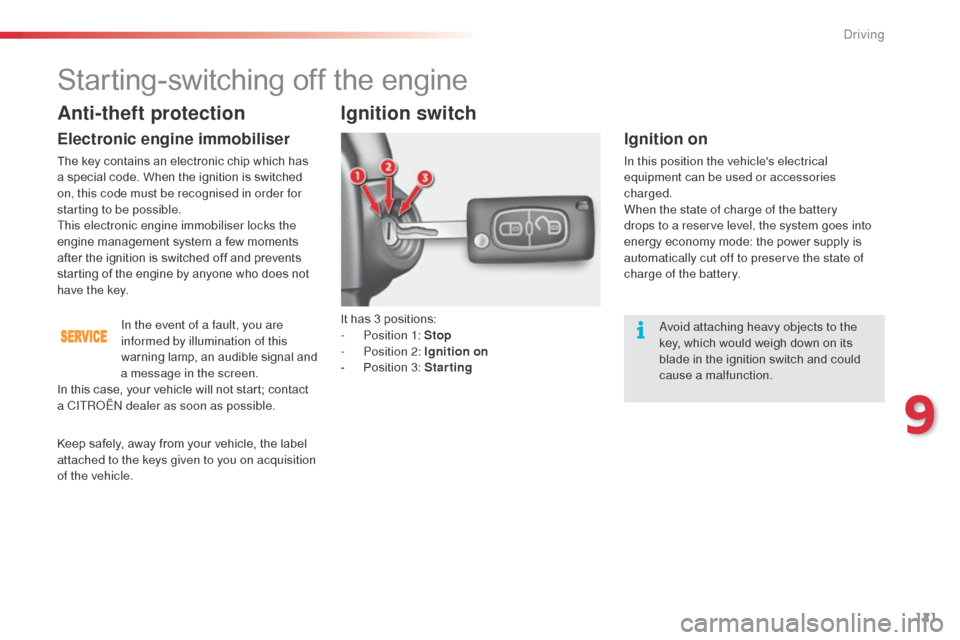
121
avoid attaching heavy objects to the
key, which would weigh down on its
blade in the ignition switch and could
cause a malfunction.
Anti-theft protection
Electronic engine immobiliser
The key contains an electronic chip which has
a special code. When the ignition is switched
on, this code must be recognised in order for
starting to be possible.
This electronic engine immobiliser locks the
engine management system a few moments
after the ignition is switched off and prevents
starting of the engine by anyone who does not
have the key.In the event of a fault, you are
informed by illumination of this
warning lamp, an audible signal and
a message in the screen.
Ignition switch
It has 3 positions:
- P osition 1: Stop
-
P
osition 2: Ignition on
-
P
osition 3: Starting
Ignition on
In this position the vehicle's electrical
equipment can be used or accessories
charged.
When the state of charge of the battery
drops to a reserve level, the system goes into
energy economy mode: the power supply is
automatically cut off to preserve the state of
charge of the battery.
In this case, your vehicle will not start; contact
a CITR
oËn
dealer as soon as possible.
Keep safely, away from your vehicle, the label
attached to the keys given to you on acquisition
of the vehicle.
Starting-switching off the engine
9
driving
Page 124 of 324
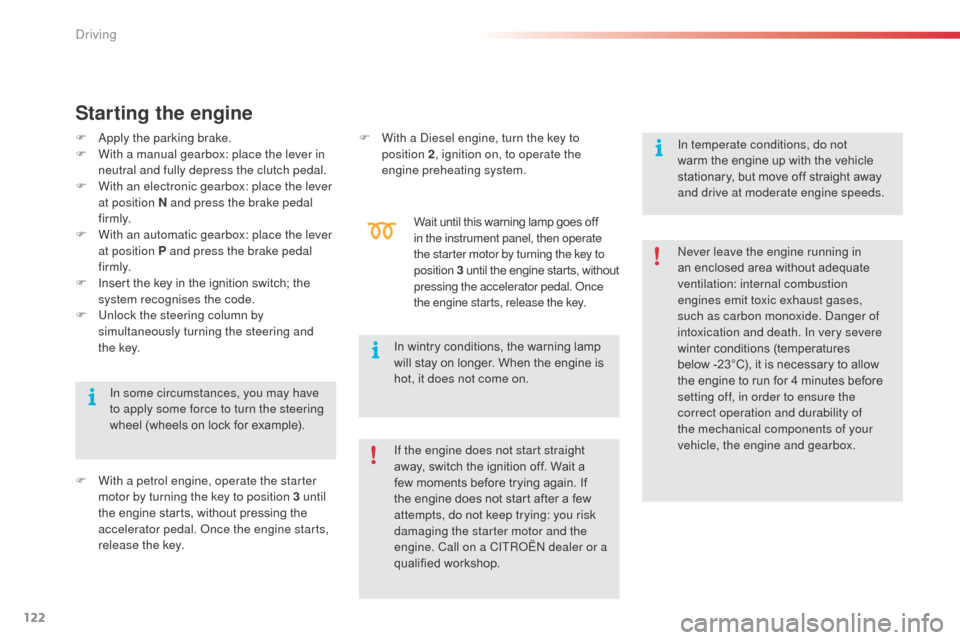
122
Starting the engine
F apply the parking brake.
F W ith a manual gearbox: place the lever in
neutral and fully depress the clutch pedal.
F
W
ith an electronic gearbox: place the lever
at position N and press the brake pedal
f i r m l y.
F
W
ith an automatic gearbox: place the lever
at position P and press the brake pedal
f i r m l y.
F
I
nsert the key in the ignition switch; the
system recognises the code.
F
U
nlock the steering column by
simultaneously turning the steering and
t h e
key.
In some circumstances, you may have
to apply some force to turn the steering
wheel (wheels on lock for example).
F
W
ith a petrol engine, operate the starter
motor by turning the key to position 3 until
the engine starts, without pressing the
accelerator pedal.
o
n
ce the engine starts,
release the key. F
W ith a di esel engine, turn the key to
position 2 , ignition on, to operate the
engine preheating system.
Wait until this warning lamp goes off
in the instrument panel, then operate
the starter motor by turning the key to
position 3 until the engine starts, without
pressing the accelerator pedal.
o
n
ce
the engine starts, release the key.
If the engine does not start straight
away, switch the ignition off. Wait a
few moments before trying again. If
the engine does not start after a few
attempts, do not keep trying: you risk
damaging the starter motor and the
engine. Call on a CITR
oËn
dealer or a
qualified workshop.
ne
ver leave the engine running in
an enclosed area without adequate
ventilation: internal combustion
engines emit toxic exhaust gases,
such as carbon monoxide.
d
a
nger of
intoxication and death. In very severe
winter conditions (temperatures
below -23°C), it is necessary to allow
the engine to run for 4 minutes before
setting off, in order to ensure the
correct operation and durability of
the mechanical components of your
vehicle, the engine and gearbox.
In wintry conditions, the warning lamp
will stay on longer. When the engine is
hot, it does not come on. In temperate conditions, do not
warm the engine up with the vehicle
stationary, but move off straight away
and drive at moderate engine speeds.
Driving
Page 125 of 324
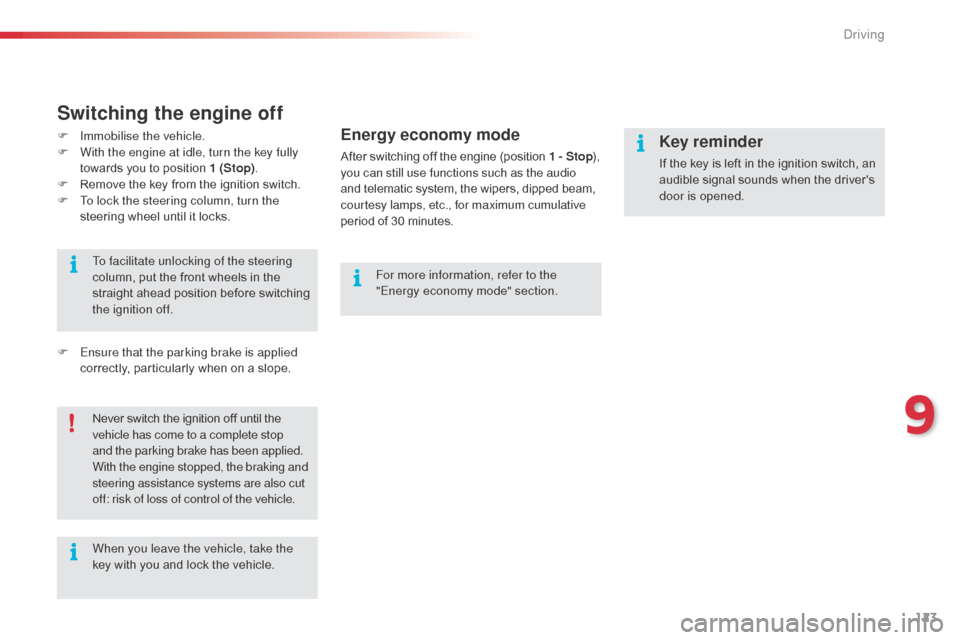
123
Switching the engine off
F Immobilise the vehicle.
F W ith the engine at idle, turn the key fully
towards you to position 1 (Stop) .
F
R
emove the key from the ignition switch.
F
T
o lock the steering column, turn the
steering wheel until it locks.
Never switch the ignition off until the
vehicle has come to a complete stop
and the parking brake has been applied.
With the engine stopped, the braking and
steering assistance systems are also cut
off: risk of loss of control of the vehicle. To facilitate unlocking of the steering
column, put the front wheels in the
straight ahead position before switching
the ignition off.
When you leave the vehicle, take the
key with you and lock the vehicle.Key reminder
If the key is left in the ignition switch, an
audible signal sounds when the driver's
door is opened.
For more information, refer to the
"Energy economy mode" section.
F
E
nsure that the parking brake is applied
correctly, particularly when on a slope.
Energy economy mode
After switching off the engine (position 1 - Stop ),
you can still use functions such as the audio
and telematic system, the wipers, dipped beam,
courtesy lamps, etc., for maximum cumulative
period of 30 minutes.
9
Driving
Page 126 of 324
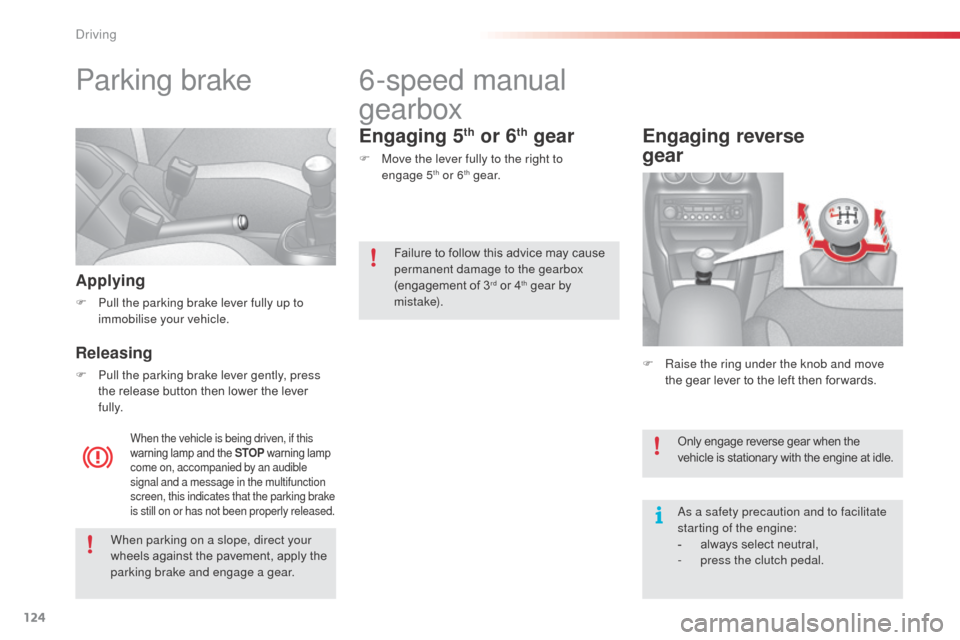
124
Parking brake
Applying
F Pull the parking brake lever fully up to immobilise your vehicle.
Releasing
F Pull the parking brake lever gently, press the release button then lower the lever
fully.
When the vehicle is being driven, if this
warning lamp and the STOP warning lamp
come on, accompanied by an audible
signal and a message in the multifunction
screen, this indicates that the parking brake
is still on or has not been properly released.
6-speed manual
gearbox
Engaging 5th or 6th gear
F Move the lever fully to the right to
engage 5th or 6th g e a r.
F
R
aise the ring under the knob and move
the gear lever to the left then for wards.
Engaging reverse
gear
Only engage reverse gear when the
vehicle is stationary with the engine at idle.
as a safety precaution and to facilitate
starting of the engine:
-
a
lways select neutral,
-
p
ress the clutch pedal.
When parking on a slope, direct your
wheels against the pavement, apply the
parking brake and engage a gear. Failure to follow this advice may cause
permanent damage to the gearbox
(engagement of 3
rd or 4th gear by
m i st a ke).
driving
Page 127 of 324
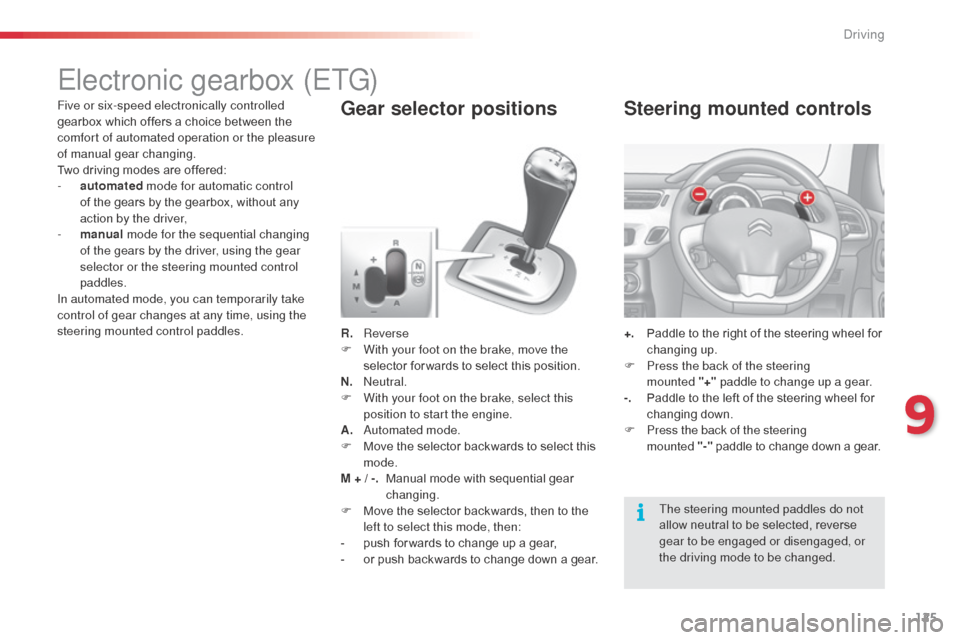
125
Electronic gearbox (ETG)
R. Reverse
F W ith your foot on the brake, move the
selector for wards to select this position.
N.
n
e
utral.
F
W
ith your foot on the brake, select this
position to start the engine.
A.
a
u
tomated mode.
F
M
ove the selector backwards to select this
mode.
M + / -.
M
anual mode with sequential gear
changing.
F
M
ove the selector backwards, then to the
left to select this mode, then:
-
p
ush for wards to change up a gear,
-
o
r push backwards to change down a gear.
Gear selector positions
+. Paddle to the right of the steering wheel for changing up.
F
P
ress the back of the steering
mounted
"+"
paddle to change up a gear.
-.
P
addle to the left of the steering wheel for
changing down.
F
P
ress the back of the steering
mounted
"-
"
paddle to change down a gear.
Steering mounted controlsFive or six-speed electronically controlled
gearbox which offers a choice between the
comfort of automated operation or the pleasure
of manual gear changing.
Two driving modes are offered:
-
a
utomated mode for automatic control
of the gears by the gearbox, without any
action by the driver,
-
m
anual mode for the sequential changing
of the gears by the driver, using the gear
selector or the steering mounted control
paddles.
In automated mode, you can temporarily take
control of gear changes at any time, using the
steering mounted control paddles.
The steering mounted paddles do not
allow neutral to be selected, reverse
gear to be engaged or disengaged, or
the driving mode to be changed.
9
driving
Page 128 of 324
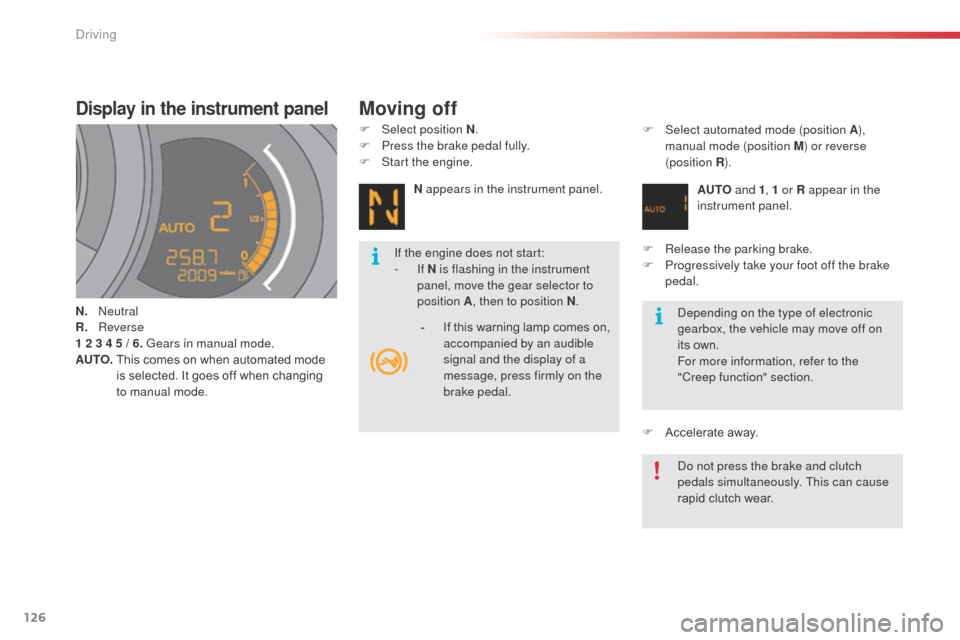
126
Display in the instrument panel
N. neutral
R. R everse
1 2 3 4 5 / 6. Gears in manual mode.
AUTO.
T
his comes on when automated mode
is selected. It goes off when changing
to manual mode. F
Sel
ect position N
.
F
P
ress the brake pedal fully.
F
S
tart the engine.
N appears in the instrument panel. F
Sel
ect automated mode (position A
),
manual mode (position M ) or reverse
(position R ).
AUTO and 1, 1 or R appear in the
instrument panel.
F
R
elease the parking brake.
F
P
rogressively take your foot off the brake
pedal.
F
A
ccelerate away.de pending on the type of electronic
gearbox, the vehicle may move off on
its own.
For more information, refer to the
"Creep function" section.
do n
ot press the brake and clutch
pedals simultaneously. This can cause
rapid clutch wear.
If the engine does not start:
-
If
N is flashing in the instrument
panel, move the gear selector to
position A , then to position N .
Moving off
- If this warning lamp comes on,
accompanied by an audible
signal and the display of a
message, press firmly on the
brake pedal.
Driving
Page 129 of 324
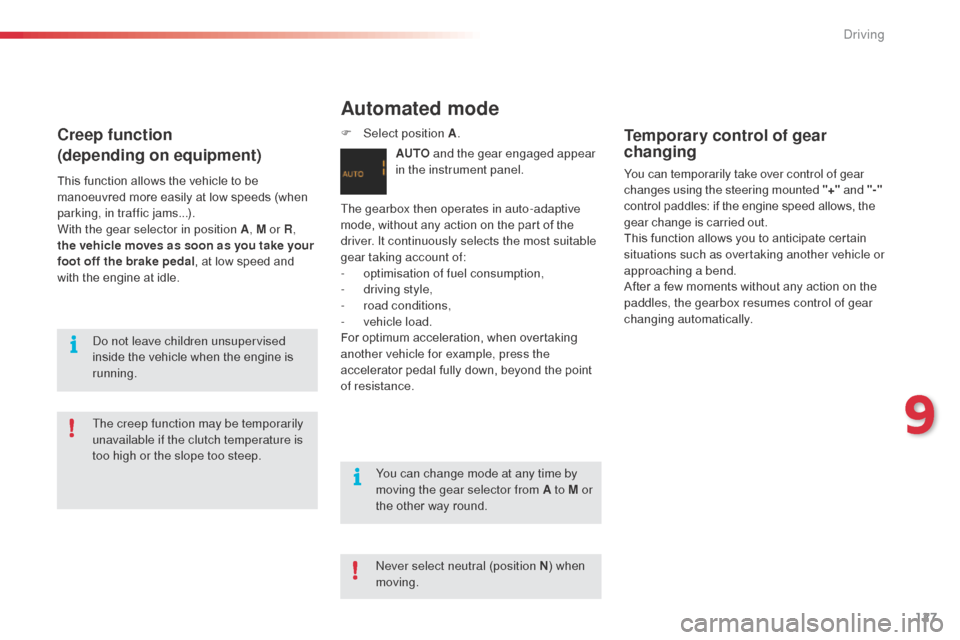
127
Automated mode
AUTO and the gear engaged appear
in the instrument panel.
The gearbox then operates in auto-adaptive
mode, without any action on the part of the
driver. It continuously selects the most suitable
gear taking account of:
-
o
ptimisation of fuel consumption,
-
d
riving style,
-
r
oad conditions,
-
v
ehicle load.
For optimum acceleration, when overtaking
another vehicle for example, press the
accelerator pedal fully down, beyond the point
of resistance.
Temporary control of gear
changing
You can temporarily take over control of gear
changes using the steering mounted "+" and
"-"
control paddles: if the engine speed allows, the
gear change is carried out.
This function allows you to anticipate certain
situations such as overtaking another vehicle or
approaching a bend.
After a few moments without any action on the
paddles, the gearbox resumes control of gear
changing automatically.
Creep function
(depending on equipment)
This function allows the vehicle to be
manoeuvred more easily at low speeds (when
parking, in traffic jams...).
With the gear selector in position A , M or R,
the vehicle moves as soon as you take your
foot off the brake pedal , at low speed and
with the engine at idle.
do n
ot leave children unsupervised
inside the vehicle when the engine is
running.
You can change mode at any time by
moving the gear selector from A to M or
the other way round.
The creep function may be temporarily
unavailable if the clutch temperature is
too high or the slope too steep.
ne
ver select neutral (position N) when
moving.
F
Sel
ect position A
.
9
Driving
Page 130 of 324
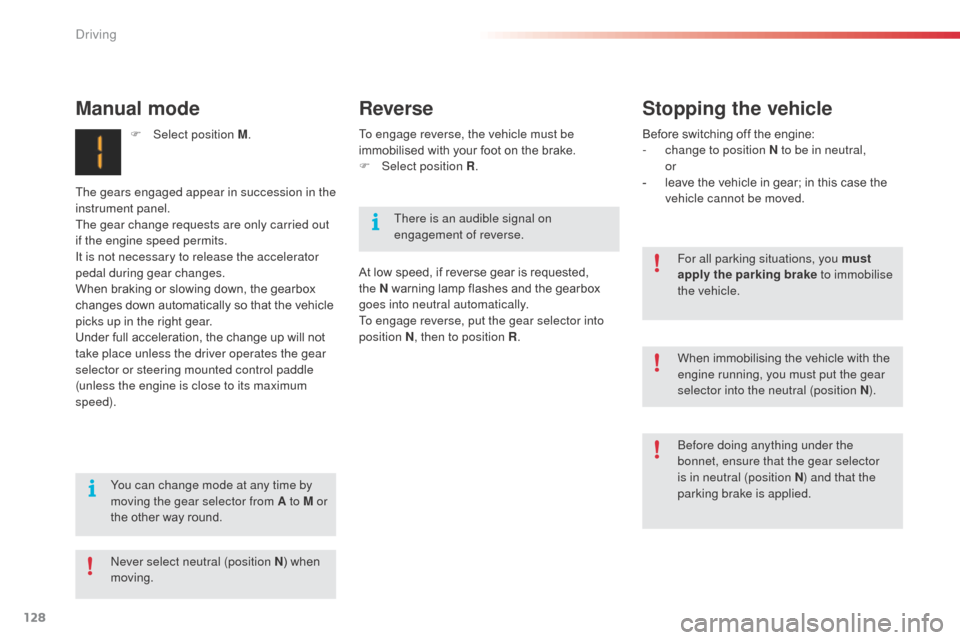
128
To engage reverse, the vehicle must be
immobilised with your foot on the brake.
F
Sel
ect position R .
At low speed, if reverse gear is requested,
the N warning lamp flashes and the gearbox
goes into neutral automatically.
To engage reverse, put the gear selector into
position N , then to position R .
There is an audible signal on
engagement of reverse.
You can change mode at any time by
moving the gear selector from A to M or
the other way round. Before switching off the engine:
-
c hange to position N to be in neutral,
or
-
l
eave the vehicle in gear; in this case the
vehicle cannot be moved.
For all parking situations, you must
apply the parking brake to immobilise
the vehicle.
ne
ver select neutral (position N ) when
moving.
Manual mode
F Select position M .
The gears engaged appear in succession in the
instrument panel.
The gear change requests are only carried out
if the engine speed permits.
It is not necessary to release the accelerator
pedal during gear changes.
When braking or slowing down, the gearbox
changes down automatically so that the vehicle
picks up in the right gear.
Under full acceleration, the change up will not
take place unless the driver operates the gear
selector or steering mounted control paddle
(unless the engine is close to its maximum
speed).
Reverse Stopping the vehicle
before doing anything under the
bonnet, ensure that the gear selector
is in neutral (position N) and that the
parking brake is applied. When immobilising the vehicle with the
engine running, you must put the gear
selector into the neutral (position N ).
driving